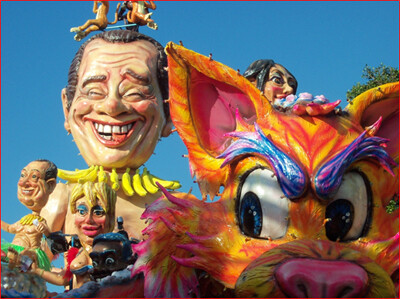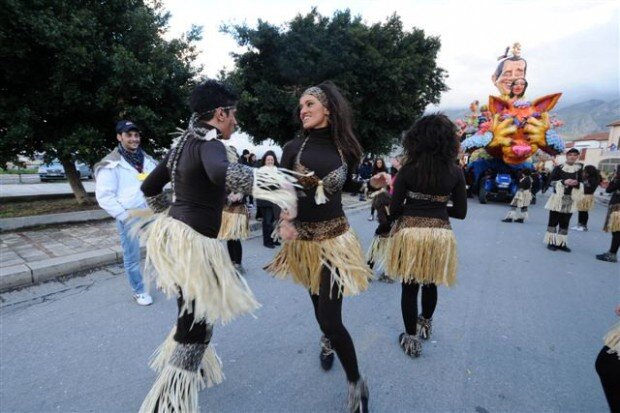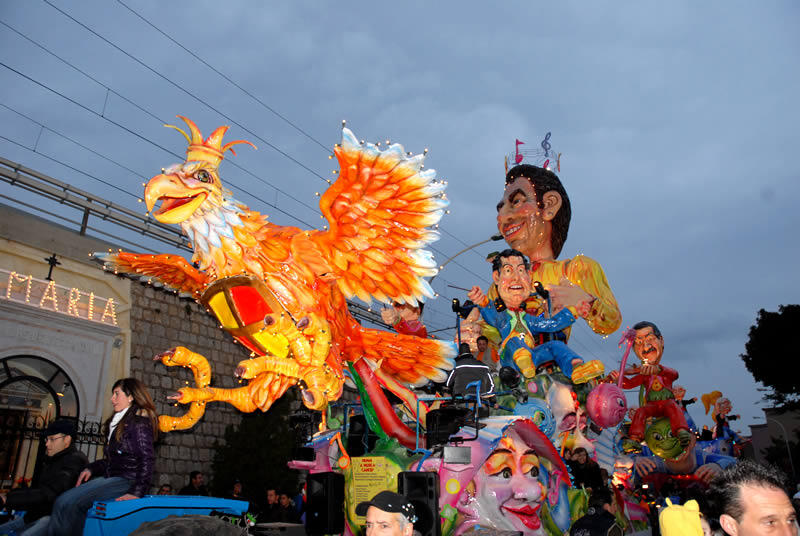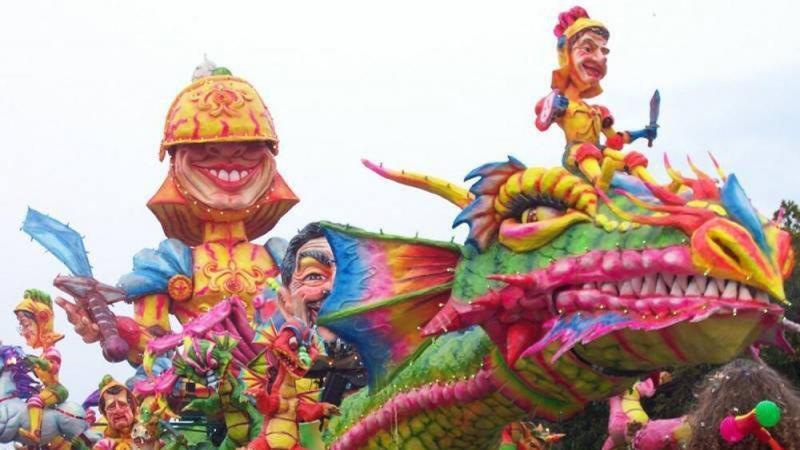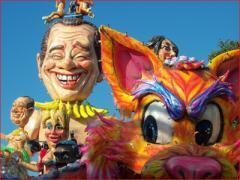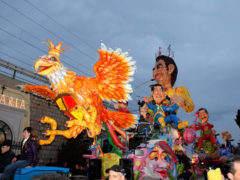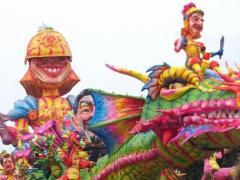Termini Imerese Carnival
Street View (if present)
Description
Termini Imerese Carnival
----------------
Technical sheet prepared by: Region of Sicily - Department of cultural heritage and Sicilian identity - CRicd: Regional center for inventory, cataloging and documentation and Sicilian regional film library
N. Prog. 79
Well: Carnival
Book: REI - Book of celebrations
Approval date: 13-04-2007
Category: Party
Province: Palermo
Municipality: Termini Imerese
Chronological News
In Termini Imerese, a spa town on the slopes of Monte S. Calogero, the oldest Carnival in Sicily takes place which attracts a large number of people every year.
The birth of this tradition is probably linked to the settlement of a large group of Neapolitans, who fled from Palermo, who took refuge in Termini Imerese following a riot that broke out in 1848 for the expulsion of the Bourbons. THE napulitì, as they are called, it is said that they lived in the area now called "Porta Palermo", where there is still a small street named Napolitì, it was a village outside the city gates where mainly poor people lived. Thanks to their proverbial joy and sympathy, they didn't take long to settle in and, on the occasion of the carnival period, they gave life to an impromptu public party, which saw the participation of a group of local farmers and fishermen, it was a party that initially it involved only the neighborhood and that only later did it involve the whole city. This u cuntu which is handed down and narrates the beginning of the Termitan Carnival celebrations.
That of Termini Imerese is considered the oldest Carnival in Sicily as it refers to four payment receipts "with a monthly fee of one lire", issued respectively in the months of January-February, March, April and May of the year 1876 , from the “Società del Carnovale” to the termitan Giuseppe Patiri (1846-1917) palethnologist, scholar of local history and popular traditions, as well as a member of the association. These important documents were found in 1997 by Giuseppe Longo, who was carrying out a laborious historical research on the Termitan Carnival, among the countless testimonies of local history collected in the house of the well-known collector Francesco La Mantia. Furthermore, the stamp on the receipts depicts a mask with features quite similar to those of the Neapolitan Pulcinella. It is therefore conceivable that this association made direct reference to the local Carnival inspired by the Neapolitans, probably taking care of its promotion and organization. Certainly, already in 1876, the event had achieved great popularity, constituting a fixed appointment between the festivals of the city and requiring the presence of a real organizing committee, which operated, with alternating events, at least until 1911.
The “Società del Carnovale” also financed the construction of the large dormitory hall of the “Umberto I” Hospital with the proceeds of 1906. The plaque placed on the façade of this former building bears the following inscription: "WITH THE CONTRIBUTION OF CITY CHARITY THE CARNIVAL COMMITTEE EXPANDED THE PREMISES FROM 1904 TO 1907, SHOWING HOW TO COUPLE THE LITTLE ONE CAN / TO BENEFIT".
The carnival period began immediately after the Epiphany (Ddoppu li tri re Carnalivari is!) and was announced by the children who, in the popular neighborhoods, playing the brogna sang "Hee heh carnalivari is". The party then lasted for a month, and was marked by the so-called "four joviri"(The four Thursdays): iòviri of them cummari(Thursday of the wives), iòviri of them relatives (on Thursday of relatives), iòviri zzuppiddu (Devil's Thursday), and ended with iòviri rassu (Shrove Thursday); on that occasion, at lunch, we stuffed ourselves withmaccaruna cu sucu 'ntà majdda, homemade pasta with i busi from the hands of grandmothers and mothers who, to dry it, spread it on the reeds.
The termitan historian Giuseppe Navarra told that at the end of the nineteenth century, by the De Giorgi brothers, the two papier-mâché masks were born. u nannu and to bed, symbol and main attraction of the Termitan Carnival. The actual party in fact exploded on Sunday with the arrival of the they go to sleep who came from afar, people in fact concentrated at the port or at the station to welcome the two sprightly old men who dispensed sugared almonds and confetti with glee and lightheartedness. The highlight of the festival was the burning of a puppet (u nannu), which was carried in procession hanging from a cane and followed by weeping extras (the repitants); the symbolic death of the puppet was preceded by the reading of rhymes and motets (u tistamentu) who mocked the established power.
The wait before the parade of floats and the explosion of the party in the square, we lived intensely in the family with evening meetings, full of joy, especially on Saturdays when parties were organized and had fun to the sound of a accordion, a guitar, a mandolin, afriscalettu, Of a mariuolu, consuming typical sweets such as chiacchere, taralli, Catalans, mustaches, cannoli, and homemade rosolio. In fact, nobles and bourgeois richly masked, traveled the streets of the city aboard carriages, to go to the many palaces where masked balls were held. The cheering populace witnessed their passage, unaware witness of what we can consider the first parades of floats that are called precisely in memory of that period the carruzzati.
The streets were also teeming with masked people who, according to custom, knocked on the door from where a sound came: the guide introduced himself and made himself known, asked for a dance, went away to knock on another door and so for a good part. of the night.
Recurrence: Annual
Date: Saturday, Sunday and Tuesday preceding Ash Wednesday
Occasion: Carnival preparatory to the penitential period of the Ashes
Function: Propitiatory
Actors: Local characters who represent the traditional masks of "u ' Nannu ca Nanna","u 'Notaro Menzapinna”, Masked groups participating in the parades of allegorical floats.
Participants: Local community, tourists
Description
The Termitan Carnival represents a moment of great popular festival, an important event that attracts tens and tens of thousands of spectators every year and attracts the attention of the general public and the media for the allegorical floats, for the musical events and the shows organized. . The party, which once lasted for a whole month, today is concentrated in three days, Saturday, Sunday and Tuesday preceding Ash Wednesday, and everything revolves around the two masks that have always been the undisputed protagonists of the Termitan Carnival, u Nannu ca Nanna, which mark the central moments of the party. It begins with the expectation by the entire population of the two protagonists that tradition has it that they come from far away, but the real party begins with the delivery of the keys to the city by the Mayor at Nannu ca Nanna, ceremony that takes place in the Cammara Picta, at the historic town hall in Piazza Duomo. Following the program of the event includes the traditional parades of masked groups and allegorical floats, the carruzzati, real works of art, fruit of the mastery of papier-mâché master craftsmen. Two of these parades take place in the lower Termini circuit, on Saturdays and Sundays, and a final one, on Shrove Tuesday, in upper Termini. In addition, the program includes a series of important collateral initiatives that are particularly interesting from a cultural point of view as well as playful-recreational. The grandparents visit the schools of the town, food and craft stands are prepared near the places where the parade of floats takes place, musical performances are organized in the square. On the evening of Shrove Tuesday in Piazza Duomo the reading of the "moral" Testament made byNotary Mezzapinna, which in fact is the saddest moment in which u 'Nannu he sacrifices himself to put an end to the revelry and prepare everyone for Lent. In the Testament, local politicians were especially targeted, and not infrequently particularly well-known ordinary people or prominent personalities; contrary to what one might think, be mentioned in the will of the Nannu it was generally welcome. For some time, in the city, even two were read, one in Termini Bassa and one in Termini Alta, the latter almost always in front of the door of the Town Hall, under whose staircase in the large square thousands of people gathered cheering. Until a few decades ago, the reading of the Testament was quite long and often lasted for a good half hour, but today it has been resized since the audience has also changed, largely made up of people from other centers to whom references would be difficult to understand. to facts and characters of a purely local nature. After the reading of the Testament we move towards the conclusion of the event with the awarding of the floats and the famous iocu re focu(fireworks) at the Belvedere of Termini Imerese.
REFERENCES
Monasta, Enza. 2005. The oldest Carnival in Sicily in Termini Imeresein Travel notes: Folklore, history and religiosity in Sicily, Syracuse: Emanuele Romeo Editore.
Longo, Joseph. 2012. The ancient Carnival of Termini Imerese, Rome: ArcheoNews.
Pitre, Giuseppe. 1979. Uses and customs, beliefs and prejudices of the Sicilian people, vol. 1, Bologna: Ovens Edition.
Toschi, Paul. 1955. The origins of the Italian theater. Turin: Bollati Boringhieri Publisher.
Footnotes
The protagonists of the Termini Imerese Carnival are:
- U Nannu represents the anthropomorphization of the Carnival itself, it is the main mask, acclaimed by the crowd, unaware of its destiny, jovial and cheerful who greets everyone waving a handkerchief, as well as throwing sweets and confetti to children and young women, it is also usually reserved for the rest of the population scurrilous gestures and various jokes showing, from the top of the allegorical wagon that houses it, enormous fennel, turnips and ropes of sausages with evident offensive intentions.
He is represented by a short, ruddy, cheerful and rather neat-looking figure, wearing a gold-colored damask jacket, a laced bib, a waistcoat, a pair of beige trousers, shoes and a walking stick as used in the local petty bourgeoisie.
- To sleep it is a not completely traditional mask that today survives in Sicily only in Termini Imerese, but was once present also in Palermo. This figure, a real female alter ego of nnodded, may have a link with ancient fertility-related cults. Pitrè, for example, associates the figure of the sleep in the presence of another carnival character, an infant that the woman carries in her arms. Among the many forms in which this old woman is represented in the various regions, the folklorist Paolo Toschi affirms that two fundamental types can be distinguished: the lean and lanky old woman, which is identified with Lent and represents the termitan carnival, and the gigantic one, adorned and filled with fruit and sausages, which therefore has a propitiatory meaning of fecundity and abundance, approaching the figure of the Befana. In these two fundamental types, Toschi sees the two main aspects of the rite: that of eliminating evil, by marking or burning the puppet, and that of propitiating fertility and abundance by throwing sugared almonds, fruit and coins. There Nanna of Termini Imerese, she is thin, tall, and shows up in a pink and gray dress, with a large hat adorned with flowers and a scarf, in the company of nannu, in the parade, he moves with his hand a large flower made of a broccoli intertwined with colorful radishes.
- The Notary Menzapinna is a fairly recent character, whose features are nothing more than the papier-mâché caricature of his creator Nando Cimino, also author of the Testament that is read in the square every year since Notary. The original name of the character derives from the fact that, in drawing up the documents, due to unwillingness or by mistake, he often left the words unfinished, arousing the hilarity of his customers who thus taking a cue from other kinds of slander, had begun to call him with this nice appellation.
The oldest document, or the receipt relating to January-February 1876, was made known to the general public for the first time, on the occasion of the vernissage of February 1998, on the occasion of an exhibition entitled: "An ancient Carnival", curated by Giuseppe Longo, in collaboration with the Pro Loco of Termini Imerese. The exhibition brought together a large documentary corpus consisting of: photographic images and films that spanned a long period of time between 1950 and 1990. The exhibition was set up in the halls of the Circolo Margherita in Termini Imerese, on the very central Piazza Duomo.
A review of the most representative images was also included in the exhibition held in the premises of the Baldassare Romano Civic Museum, in February of the same year. The exhibition, "Masks and masks in Sicily from the 600s to today", was commissioned and curated by Professor Rosa Maria Dentici Buccellato, then the Councilor for Culture of the Municipality of Termini Imerese. A place of honor in this case was also given to the certificate issued in January 1876.
The celebration of Carnival, with the parade of allegorical papier-mâché floats, masquerades and unbridled revelry, renews every year an ancient story that has fascinated great scholars of popular traditions, who have found continuity with the Saturnalia, a Roman festival in honor of Saturn which took place at the end of the rural festivals that began with sowing on the winter solstice and which probably meant the end of a cycle and the beginning of a new time: spring. At the end of the Termini Imerese Carnival a puppet is burned, u nannu, which represents the old, the past to be destroyed in order to pass to a new life, following the propitiatory ritual of the stake as a legacy of the ancient pagan rite.
Author Profile: Maria Rosaria Paterno '
Go to Google Maps
Send a notice to the publisher
[contact-form-7 id="18385"]

